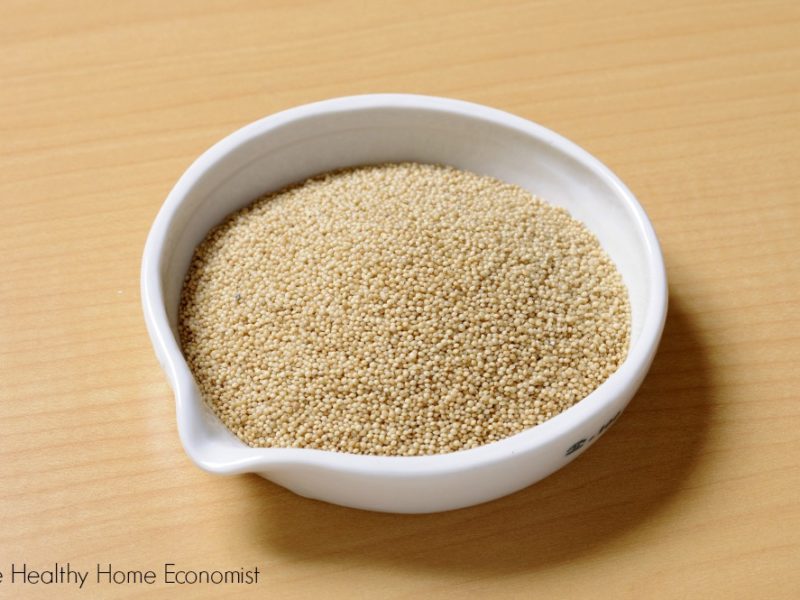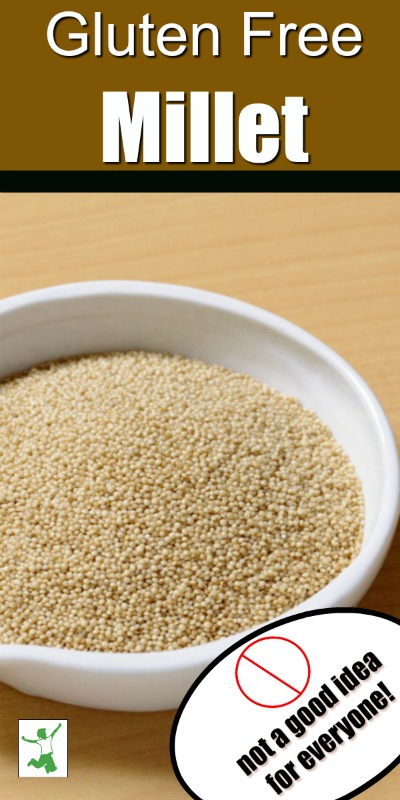Examination of why millet should optimally be eaten in moderation as a gluten-free whole grain in order to avoid disrupting hormone health.

Gluten allergies are clearly on the increase in our modern society. It seems like practically every other person I know these days has some sort of digestive issue that avoiding gluten would probably improve.
At the top of the list of gluten-containing foods is wheat. It is the indisputable, primary staple of the Western diet. Wheat is also the very foundation of the controversial USDA Food Pyramid.
Given how important bread and other wheat-based carbohydrates are to our society’s basic food requirements, it’s no wonder that folks seek a quick and easy substitute for wheat bread and wheat-based snacks when a gluten allergy or Celiac disease has been diagnosed.
Millet: Ancient Gluten-free Whole Grain
Enter millet. This ancient grain was cultivated in East Asia as far back as 10,000 years ago, according to archaeologists. Surprisingly, the cultivation of millet in prehistoric times was more prevalent than even rice, particularly in what is now China and the Korean peninsula.
Millet’s resistance to drought is perhaps the reason for its popularity in ancient times and its spread to Europe by 5000 B.C.
Despite the 5000 years cultivating this whole grain as a staple food, millet porridge is considered a traditional food in Russia as well as China. Use of millet is also widespread in Africa, like gluten-free teff, likely due to the drought-prone climate.
Millet Bread: Logical Substitute for Wheat
The protein structure of millet is quite similar to wheat. The one glaring exception is that millet is a gluten-free grain. Wheat contains copious amounts of this hard to digest plant protein.
When plain millet flour is used for baking bread (as opposed to homemade gluten-free flour or a healthy gluten-free flour mix from the store), the resulting loaf is light, white, and quite similar in texture to wheat bread. As a result, people who wish to avoid gluten tend to immediately gravitate to millet bread as the most logical and palatable substitute.
Millet bread is extremely popular in health food stores. Sami’s Bakery and Deland Bakery are two local bakeries that sell an absolute ton of millet bread to these stores around my local metro area.
I recently corresponded with a person up the East Coast of the USA who was consuming a lot of the millet/flax chips as an alternative to wheat-based snacks and had no idea of the potential health risks from consuming so much millet.
It was this discussion that led me to write this blog and warn folks about the dangers of consuming too much millet!
Potent Goitrogens
While millet does not contain gluten, it does contain goitrogens. These are substances that suppress thyroid activity and can lead to goiter. This condition involves enlargement of this very important gland which resides in the throat. Low iodine intake can also lead to goiter for those who rely on millet as a staple according to the Journal of Endocrinology and Metabolism.
Hypothyroidism is a serious and sometimes debilitating condition. It accompanies a weak or enlarged thyroid such as what occurs with goiter. Depression, difficulty losing weight, loss of hair, cold hands/feet, and fatigue are common hypothyroid symptoms. By some estimates, hypothyroidism is at epidemic proportions in Western society. (1)
Goitrogens in foods that contain them are usually reduced by cooking such as cruciferous vegetables like broccoli. However, cooking actually increases the goitrogenic effect of millet! Incidentally, the same effect occurs when fermenting soy.
Therefore, when folks begin eating large amounts of millet bread with a wholesale switch over from wheat, the thyroid suppressing effects of this simple dietary change can be profound. Injuring the thyroid can have a cascade effect on other glands as well. For example, those suffering from adrenal fatigue many times have thyroid issues as well.
Moderation is Critical
Protect your thyroid at all costs! It is a real challenge to unwind the effects of hypothyroidism once this vital gland is weakened or enlarged. Don’t take any chances with your thyroid health by consuming large amounts of millet bread or millet based snacks.
If gluten and/or wheat is a problem, then simply reduce bread consumption. Alternatively, use another grain that is both gluten-free and non-goitrogenic such as rice, oats or teff. Be sure to get quality, though, as rice is frequently high in arsenic.
Alternatively, try using grain-like gluten-free foods such as highly nutritious buckwheat, amaranth, or the starchy tuber cassava. They are excellent for baking too!
Millet bread consumption is fine in moderation if your thyroid is healthy – just don’t overdo it!
Given how difficult it is in modern society to maintain thyroid and overall glandular health, taking a chance by eating a lot of millet bread is a risky proposition indeed.
Traditional peoples did not have the constant stresses and strains on their glands like modern people do.
For example, they did not have to contend with pollution of their food, water, air and overall environment.
Therefore, we must be overprotective of our thyroid health. This includes avoiding regular consumption of foods that might impair it in any way.

Millet Alternatives That Preserve Thyroid Function
If you have thyroid issues and need alternatives to millet, here is a list of the healthiest options to consider.
- Einkorn Benefits (contains “good gluten“)
- Teff Benefits
- Yuca Root Benefits
- Arrowroot Benefits
- Wild Rice Benefits
- Farro (great if only modern wheat is the problem)








Millet is a seed not a grain
All grains are in fact a type of seed.
If you seem to have a wheat or gluten allergy, but it’s erratic and you just can’t nail it down, you are probably suffering from glyphosate exposure. Glyphosate is now sprayed on wheat and other grains just three days before harvest, in a process called desiccation. This is not done for corn, potatoes, and rice, so if you’ve gravitated to corn, potatoes, and rice in order to reduce your symptoms, this is the reason why.
You can get glyphosate-tested foods (including raw flour) if you look hard enough on the internet. Once we switched our house over to glyphosate-free foods, our whole family can eat wheat again!
The study is about feeding rats, and applying on porcine thyroid slices, different portions of the millet. That being two different grades of millet hulls, the seperated grain, extracts of millet , and the whole grain. The hulls providing the most antithyroid effects. Maybe we need to not use scareful language and misrepresentation of facts to demonize millet. Also a good understanding that humans are not rats or porcine thyroid slices. We also eat whole grains not extracts or hulls. Thanks sarah
My grandmother from China ate lots of millet porridge growing up. She doesn’t have hypothyroidism and is 96 years old now. Her brain has always been very sharp. She also doesn’t even suffer from arthritis or any physical ailments. The opposite is true…that the next generation that didn’t consume millet or had a diet like grandma’s seem to have hypothyroidism, diabetes, cancer and stroke. Grandma had outlived two of her children. She lives in our modern society but doesn’t suffer from any of these illnesses. I can only attribute it to her foundational diet of grains like millet and rice while growing up in China.
Turmeric protects against goitrogen foods. Really amazing. I’m pretty sensitive to goitroens. If I eat a good bit of broccoli or other goitrogens I don’t produce as much body heat, my metabolism slows down, I don’t rest as well, my thinking gets thick and my thyroid aches. But I stumbled upon this affect with turmeric by accident. I happened to be eating a very high goitrogen diet recently with kraut, ton of broccoli, lots of peanuts, and I was having great body heat, until I happened to run out of turmeric, and then I was miserable. One caution on turmeric, some of it can be high in lead. I’m not sure how high. I had a lead scare last month -meaning acute lead issues(tasting lead, bone and joint pain, blasted peripheral circulation). The turmeric I was using could have been part of it, but I also strongly suspect a mineral sea salt I was using. Love your article here. Totally on top of it, unlike the incompetent, alcohol loving, medical community in our beer and brat cultures -sorry, just a little lobby for a fertile mind. Also, I’ve eaten a fair amount of millet the last two days, about 1.7lbs, and while I am having reduced body heat and some possible thyroid ache, there’s also a positive element to it and the thyroid was pretty mild seemed like, with no turmeric in my diet. I like how easy it is to cook. Love the pilaf type texture. I can’t get rice right but you almost can’t get millet wrong. and the stomach feel is very light, even more so then rice I’d say. I’m hungry right after eating, but then long term it seems more satisfying. And finally, I try to eat organic and millet cheaper then oats at the store here. 🙂 I think the oats make for a lower calorie meal however, because the millet is very dense.
Love and courage, Bill.
I would be interested to know exactly how much millet one would have to eat for it to be a problem and is millet seed the same as millet? Many Thanks.
Dear Sarah,
I live in Africa. In our country, Pearl Millet is a staple food to almost 50% of the population. I have to say, people tend to get Very old here with not a lot of health concerns in these rural areas. And I can confirm that I have not met someone with hypothyroidism or thyroid disorders in this areas. We have very large Pearl Millet plantations. I am not sure if you are maybe talking about another type of Millet. Would love to know more. Thanks for the information.
That’s great to hear Hendrina. Thanks for sharing. It is likely where you are in Africa that the population is not under so much thyroid stress like those of us in the West. Millet is fine as long as there is plenty of iodine in the diet and there aren’t any pre-existing thryoid problems. Unfortunately, so many in the West have undiagnosed thyroid problems due to all the thyroid stressing chemicals etc (fluorided water and fluoride treatments at the dentist and frequent dental xrays … I could go on and on). Thus, when someone in the West starts eating a lot of millet, low level thyroid function blows up quickly into full blown hypothyroidism.
I read all the comments but never found a reply from you regarding evidence of goitrogen being present in millet even after cooking and other questions such as how about its effects for hyperthyroidism. It would be nice that after reading your article that you will also be able to find sufficient evidence or maybe answer with “no I don’t have evidence”
Sorry if that is unclear. Here’s a study where millet in the diet (as in cooked) produced negative effects on the thyroid. https://www.ncbi.nlm.nih.gov/pubmed/2921306
The modern diet is low in iodine, by the way, so this is one reason why millet can be such a problem for many who eat it regularly.
Cooking or fermenting foods (soy is another big problem food) does not alleviate goitrogens unfortunately. Sauerkraut is another food to be avoided by those who have poor iodine status as cabbage is also goitrogenic.
Rice flour is not good for the kidneys, especially rice flour produced in the United States, except California. It contains high levels of arsenic.
Do we stop eating millet or can adding other cereal like guinea corn and others together help it?